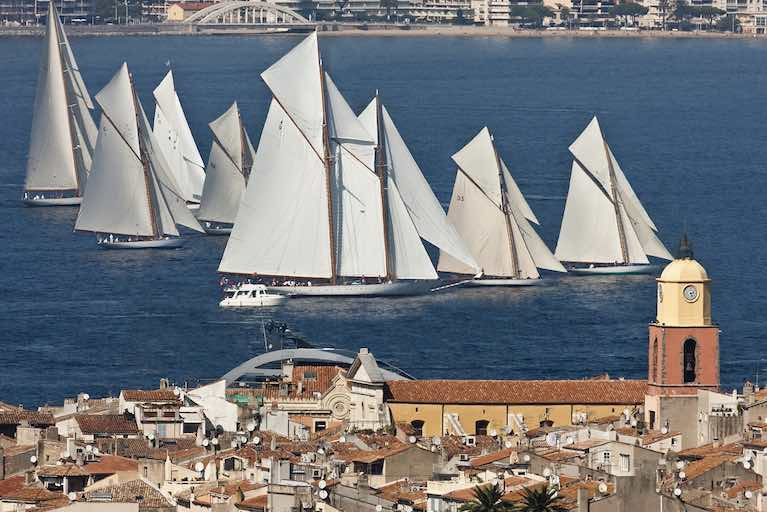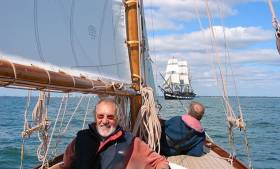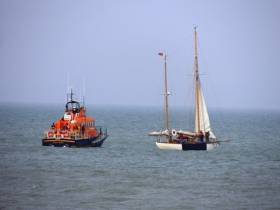Displaying items by tag: classic yacht
Greystones’ Pam Lee At Front Of Fleet In French Classics
Multi-talented offshore sailor Pamela Lee of Greystones has been at the heart of it in the annual late season Classics racing on the French Riviera, crewing on Richard Matthews’ 1898-vintage 48ft William Fife-designed-and-built cutter Kismet in a notably successful programme which included winning the Gstaad Yacht Club Centenary Trophy 2022 at St Tropez.
Richard Matthews of West Mersea, a familiar figure at Cork Week over the years, is renowned for his association with the Oyster range of performance cruisers, and a succession of top offshore racers under the Oystercatcher name. He first acquired a taste for classic restoration when he brought his late father’s Holman-designed Stella OD back to life. She was one of the first of the successful class when new, and he still sails her - he raced the Stella at Ramsgate Week in Kent in 2022.
Also in the Matthews stable afloat is the America’s Cup-targeted 12 Metre Crusader, but when he decided to go down the pure classics restoration route, it was with a boat that was a familiar sight in the neighbourhood. The originally hundred per cent Fife cutter Kismet was in a local mudberth, and had been used as a houseboat - with a large “living shed” on deck - for sixty years.
 Kismet (1898) to weather. Uneven conditions this year provided continuous sail configuration challenges…
Kismet (1898) to weather. Uneven conditions this year provided continuous sail configuration challenges…
 ….but then the Mediterranean would pause to be its most presentable self.
….but then the Mediterranean would pause to be its most presentable self.
The return route to full classic trim - using the noted talents of master craftsman Adrian Wombwell of Tollesbury, and the design input of David Cooper of Holman & Pye in West Mersea - took four patient years “and an element of budget over-run”. Initially, Kismet was a feature of Classic regattas in England, but in 2018 she made her debut in the high-powered September-October programme in the south of France. And though this has been interrupted to some extent by the pandemic, it was very much back for 2022, and particularly for the Gstaad YC Centenary Trophy at St Tropez, a feature since the GYC’s Centenary in 1998, a date Kismet shared.
 The Centenary Burgees of Gstaad Yacht Club in 1998, with the club’s regular burgee on the right. Quite how the Howth Yacht Club burgee (left) became involved is anyone’s guess.
The Centenary Burgees of Gstaad Yacht Club in 1998, with the club’s regular burgee on the right. Quite how the Howth Yacht Club burgee (left) became involved is anyone’s guess.
As it happens, the Swiss Alps-based Gstaad YC’s centenary burgee almost exactly replicates the burgee of Howth YC (founded 1895) in Ireland, and the Gstaad club shares the classic Howth Seventeens date of inauguration in 1898, so both – like Kismet - will be celebrating their 125th in 2023.
Both clubs also share distinctly hilly locations, but while HYC manages direct sea access from its clubhouse, the Gstaad sailors have to trundle down to Monaco to get afloat on salt water. As to whether or not Gstaad shares Howth’s distinction of having a hillside flock of pure-bred Old Irish Goats complete with blonde goatherd, we couldn’t possibly comment…….
MAGIC WIN OF CENTENARY TROPHY
For Richard Matthews, winning the Gstaad Centenary Trophy was a magic moment, and he commented:
“We are very happy - the boat went perfectly, we never had her going so fast to windward. And the course was perfect, we had enough wind, not too much. It was just a perfect sail. We were looking back and kept saying ‘where are they?’ We saw Scud (Ernesto Bertarelli with Torben Grael) coming up fast, but we thought we’ve got enough time, we can make it, and we did. The key moment was when we decided to change the small jib into a bigger one. We have got a great crew too - they are very good sailors, and we would love to come back next year to defend the title”.
 Kismet crosses the line off the unmistakable St Tropez waterfront to win the GYC Centenary Trophy. In an easing wind, it was the very smoothly-executed change-up to that powerful masthead Yankee jib which kept her in the lead.
Kismet crosses the line off the unmistakable St Tropez waterfront to win the GYC Centenary Trophy. In an easing wind, it was the very smoothly-executed change-up to that powerful masthead Yankee jib which kept her in the lead.
Irish interest in the series didn’t finish with Kismet, as the Royal Cork YC’s own Cork Harbour OD Jap was also racing, while probably the oldest boat in the fleet was the 1874 former pilot cutter Madcap, owned for many years and cruised far and wide by current Dublin Bay Old Gaffers Association President Adrian “Stu” Spence.
When he took his emotional farewell of Madcap to a French owner some years ago, it was in the understanding that she was going into a maritime museum situation – more or less - in La Rochelle. To hear that she’s alive and well and racing at St Tropez is great news. She’s the oldest boat aboard which I ever did the Lambay Race (we were beaten fair and square by Paddy Murphy of Renvyle racing the Galway Hooker Naomh Cronan), and this latest chapter is an appropriate addition the story of a boat which has been surprising everyone for 148 years.
 In 1998 when the Gstaad YC was celebrating its Centenary, Adrian Spence’s 1874-built former pilot cutter Madcap was in Greenland. Twenty-four years later and now in French ownership, Madcap was the oldest boat racing for the Gstaad YC Centenary Trophy at St Tropez. Photo: Frank Sadlier
In 1998 when the Gstaad YC was celebrating its Centenary, Adrian Spence’s 1874-built former pilot cutter Madcap was in Greenland. Twenty-four years later and now in French ownership, Madcap was the oldest boat racing for the Gstaad YC Centenary Trophy at St Tropez. Photo: Frank Sadlier
French Classics Succeed in Keeping a Muted Flag Flying at annual Voiles de Saint-Tropez
You might well think that trying to stage the annual sailing classics megafest of the Voiles de Saint-Tropez without the usual razzmatazz is about as likely to succeed as an attempt to stage Wagnerian Grand Opera in a low key manner. But what with pandemic restrictions and the recent ferociously destructive and sometimes fatal storms in southeast France and northwest Italy, the mood in the area was distinctly subdued. So as several sailing events have already discovered in this annus horribilis, the best thing to do was to simply quietly stage the event, and then let the photos circulate gently afterwards.
With some quality and very expensively restored classics being sold off this year at knockdown prices, it was feared that the sailing world might have passed Grand Classics peak, something exacerbated by the fact that the vital charter market is barely ticking over, if at all.
 While the tone was muted, the mood of après sailing in St Trop was still to be found. Photo: Gillles Martin_Raget
While the tone was muted, the mood of après sailing in St Trop was still to be found. Photo: Gillles Martin_Raget
But despite that, there was a varied showing at St Trop, the always impressive images capture the flavour of it all, and while the après sailing was discreet and sometimes socially distanced, it was après sailing nevertheless. And in a year starved for the sight of sails, the boats looked lovelier than ever, while those who incline towards something more modern were also well catered for, with the latest designs of Wicklow-based mark Mark Mills featuring as usual at the front of the fleet.
One local claimed that the controlled but undoubted success of the event for the times that are in it was due to some very earnest praying to St Tropez himself on his feast day, September 31st, around which time the Voiles dates were centred.
To those pernickety folk who would point out that there's no such date as September 31st, we can only respond by saying that there's no such holy man as St Tropez either. Nevertheless, you can find his image in positions of veneration on some of the walls around an entertaining little port which more often than not seems itself to be a figment of the imagination.
 Back to the classic sailing, and a decent breeze making in from seaward. Photo Gilles Martin-Raget
Back to the classic sailing, and a decent breeze making in from seaward. Photo Gilles Martin-Raget
Darryl Hughes is December Sailor of the Month (Classics)
Darryl Hughes is so completely identified with his classic 43ft 1937 Tyrrell-built ketch Maybird (whose superb restoration he project-managed himself) that, as Maybird shares her home port between Crosshaven in Cork and Poolbeg in Dublin, both places can claim this award-winner as one of their own. The Hughes/Maybird partnership had a vintage year in 2018, becoming the first gaff-rigged yacht – and the oldest - to complete the Volvo Round Ireland Race, for which they were both the winners of the Penmaen Plate for best exemplifying the Spirit of the Irish Sea Offshore Racing Association, and the Arthur Hughes Trophy for the top boat in the Dublin Bay Old Gaffers Association.
In addition, Darryl comprehensively organised the fully-subscribed international symposium in the Royal Irish YC on Weather and Sailing in collaboration with the Irish Meteorology Society and the Royal Institute for Navigation.
Dun Laoghaire Regatta Casts Net To Celebrate Kingstown Bicentenary
There could well be as many opinions as to what constitutes a true classic or traditional boat as there are owners of these often highly individual craft. As part of the celebration of the Bicentenary of Dun Laoghaire Harbour – where the first stone was officially laid by the Viceroy on 31st May 1817 - the organisers of the Volvo Dun Laoghaire Regatta 2017 (it’s from July 6th to 9th) will be including a Classics, Traditional and Old Gaffer section. This will, in addition to putting extra emphasis on older classes already regularly involved such as the Glens, the Mermaids, the Howth 17s, the IDRA 14s and the Water Wags, be extending a welcome to older boats of other types, and to classic classes from Ireland and around the Irish Sea. W M Nixon reports on progress in this special feature of a very attractive new dimension to Ireland’s biggest sailing event.
If you want anything done in introducing a new twist to sailing, make Cathy MacAleavey the organiser of the special sub-committee in charge of moving things along. And if you want to be sure things are going in the right direction as regards classics and traditional craft, make sure that that Hal Sisk is being consulted and will be personally involved in one or maybe all of his classic craft, for the contribution he has made to the appreciation of our boat heritage in Ireland is unmatched.
Former Olympic sailor and round Ireland record holder Cathy is now herself very much a mover and shaker in the classics, as she has built a Water Wag and a Shannon One Design working alongside the great Jimmy Furey of Leecarrow in Roscommon, and races regularly in both classes.
On being appointed to this completely new post last Autumn by top honcho Tim Goodbody, Chair of the overall Organising Committee, one of the first things she remembered was that while taking part in the Glandore Classics some years ago, she’d been much taken with the Fife One Designs from the Menai Straits, little gems some 24ft 6ins LOA whose design origins go back to 1926, and have been thriving as a class since the 1930s.
 The Royal Anglesey Fifes racing in the Menai Straits. Although the class was first designed in 1926, and gained full strength early in the 1930s, this will be their first visit to Dun Laoghaire. Photo: Ian bradley
The Royal Anglesey Fifes racing in the Menai Straits. Although the class was first designed in 1926, and gained full strength early in the 1930s, this will be their first visit to Dun Laoghaire. Photo: Ian bradley
These days they hunt as a pack and many of them are well organised for road trailing, so on the assumption that they would be heading to the Glandore Classics 2017 on July 23rd, she sent an email to class chairman Richard Tudor suggesting that they might like to take in Dun Laoghaire on the way. It turns out that they won’t be at Glandore in late July as they’re expected to take part in the four yearly Celtic Festival in the Menai Straits at much the same time. But their diary was reasonably clear for the 6th to 9th of July and the Dun Laoghaire festivities, and they’re coming to race for the new Kingstown Cup big time.
This is doubly interesting, for they’re very much a William Fife design and only six inches shorter than the Alfred Mylne-designed Glens, yet the two comparable classes have never raced in the same event. Needless to say the chances of an inter-fleet race in Dun Laoghaire is now high on the agenda.
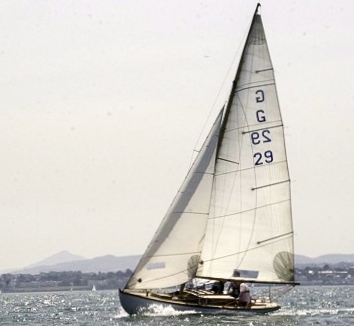 An Alfred Mylne-designed Glen Class OD on her home waters of Dublin Bay in the kind of conditions everyone hopes for in July 2017.
An Alfred Mylne-designed Glen Class OD on her home waters of Dublin Bay in the kind of conditions everyone hopes for in July 2017.
 The Glen class neatly demonstrate their need for traditional moorings in their allocated area off the Royal St George YC
The Glen class neatly demonstrate their need for traditional moorings in their allocated area off the Royal St George YC
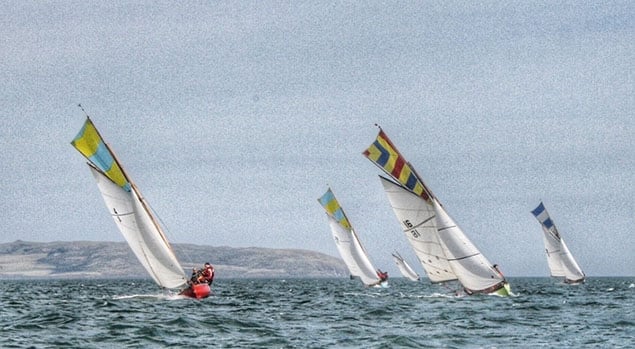 The 1898 Howth 17s will be coming in force from Howth, but they’ve adapted the programme to suit their needs, with a race from Howth to Dun Laoghaire on the Friday, a full day’s racing on the Saturday, a morning race on the Sunday, and then a race home after the prize-giving ceremony.
The 1898 Howth 17s will be coming in force from Howth, but they’ve adapted the programme to suit their needs, with a race from Howth to Dun Laoghaire on the Friday, a full day’s racing on the Saturday, a morning race on the Sunday, and then a race home after the prize-giving ceremony.
So at a stroke, Cathy had given wings to the new event. But at the same time she was casting a fly over Hal Sisk, against whom she regularly races in the Water Wags, but who had his 1894 Watson-designed, Hilditch-built 36ft classic gaff cutter Peggy Bawn on the market, as more than ten years have elapsed since his team completed the wellnigh perfect restoration of this boat in 2005.
Peggy Bawn had been based in Dun Laoghaire Harbour continuously since 1919, and then after her restoration, she became a much-admired feature in classic regattas on both sides of the Atlantic. To say that Hal Sisk has done his duty by her is under-stating the case, yet when Cathy approached him about making Peggy Bawn the centrepiece of the VDLR Classics Regatta, he said he’d already decided to do so, and was looking forward to it very much.
 Peggy Bawn in her newly-restored form in 2005. Anyone contemplating a similar project should spend hours studying this image……Photo W M Nixon
Peggy Bawn in her newly-restored form in 2005. Anyone contemplating a similar project should spend hours studying this image……Photo W M Nixon
While all this was going on in the background, one of the members of Cathy’s sub-committee, Guy Kilroy, was constructing a database of all the classic and traditional classes within Ireland or within reasonable reach. Although most of them are very location-specific and few have the trailers for a long road journey, you just never know who might be swept up in the general enthusiasm for an event which is really beginning to buzz, and certainly the exotic Shannon One Designs will be turning up in strength.
Meanwhile, there’s the mysterious territory which is the Old Gaffer’s Association, which came into being in 1963 when people realised there wasn’t any organisation looking after the needs of boats which weren’t really classics in the strictest sense, yet fitted into so many other categories that they almost defied definition.
Ironically, the OGA was founded in the very year that Dublin Bay’s perfect exemplars of the gaff-rigged racing cutter, the Dublin Bay 21s, changed over to Bermudan rig. Yet as the 2013 Golden Jubilee Round Britain and Ireland cruise of the OGA showed, the Old Gaffers thrive as never before. And as it happened, in 2015 and 2016 the President of the overall Old Gaffers Association was Dun Laoghaire’s own Sean Walsh, owner-skipper of the very gaff-rigged Heard 28 Tir na nOg.
But Sean was due to stand down as President in London in January 14th 2017 – last weekend, in other words. Fortunately, there was just time to convene a meeting of key people before that happened, and a gathering in the NYC of Sean Walsh, Dublin Bay OGA President Denis Aylmer, Ian Malcolm of the Howth Seventeen and Water Wag classes, and Cathy MacAleavey and her husband Con Murphy, did a lot to improve mutual understanding and clarify the in-port needs of Old Gaffers, which are different from those of Classics, which are in turn very different from those of easily-manoeuvred modern craft with auxiliary engines.
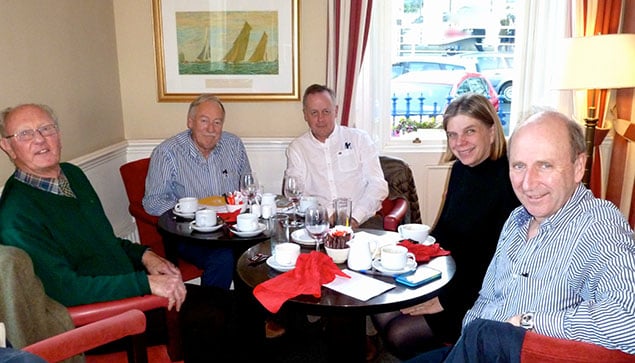
Even before Sean and his team had left for London for the OGA changeover, the word had come through from Paul Keogh, skipper of the Clondalkin community-owned-and-built full-size Galway Hooker Naomh Cronan, that he and his crew would be delighted to take part in Dun Laoghaire in July.
This was another key decision, for the Naomh Cronan is now the only full-sized traditional Galway type on the Irish Sea. But while the great hooker voyager Paddy Barry now sails the seas in a 45ft Frers-designed cutter, it was also confirmed that he too would be taking part, as crew aboard Sean Walsh’s Tir n nOg.
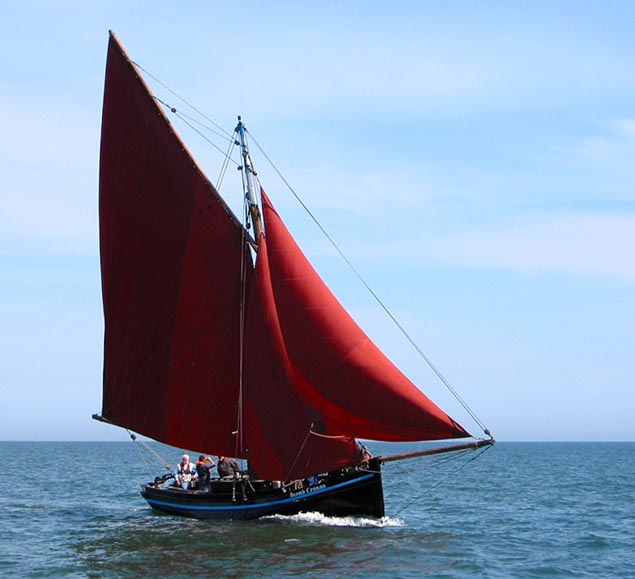 The Clondalkin community-built Galway Hooker Naomh Cronan. Her commitment to the Dun Laoghaire Traditional regatta has greatly encouraged the organisers. Photo: W M Nixon
The Clondalkin community-built Galway Hooker Naomh Cronan. Her commitment to the Dun Laoghaire Traditional regatta has greatly encouraged the organisers. Photo: W M Nixon
 Sean Walsh’s Heard 28 Tir n nOg in racing mode. In Dun Laoghaire in July 2017, his crew will include legendary Galway hooker voyager Paddy Barry. Photo: Dave Owens
Sean Walsh’s Heard 28 Tir n nOg in racing mode. In Dun Laoghaire in July 2017, his crew will include legendary Galway hooker voyager Paddy Barry. Photo: Dave Owens
So the main building blocks of a great event are now going into place, and it’s a matter of building on this sound foundation. With the organisers fully aware of the need to provide proper liaison officers for each special group or class, the need for designated berthing between the Carlisle Pier and the East Pier is also being addressed, as it is the most suitable space, and has the bonus of providing the best possible public view of some of the most interesting-looking boats around.
Thus invitations are on their way to the likes of Scott and Ruth Metcalfe with their characterful schooner Vilma on the Menai Straits, and Mike Clark with his traditional Manx nobby White Heather at Peel in the Isle of Man.
 The Menai Straits-based schooner Vilma (Scott & Ruth Metcalf) is exactly the kind of vessel the Dun Laoghaire event is aimed at. Photo: W M Nixon
The Menai Straits-based schooner Vilma (Scott & Ruth Metcalf) is exactly the kind of vessel the Dun Laoghaire event is aimed at. Photo: W M Nixon
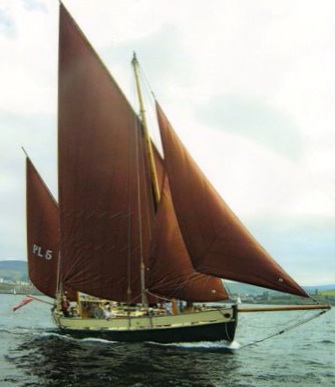 Mike Clark’s Manx Nobby White Heather
Mike Clark’s Manx Nobby White Heather
At the other end of the Isle of Man is Joe Pennington with his restored Manx longliner Master Frank, an asset to any regatta, while across in Strangford Lough Dickie Gomes may have his 1912-built 36ft Kearney yawl Ainmara on the market after 51 years of ownership, but if she doesn’t move he says he is on for Dun Laoghaire.
For several years. Ainmara was Dun Laoghaire-based, but the Dun Laoghaire class which everyone would most particularly welcome back would be the Dublin Bay 24s which raced in the bay from 1947 to 2004. Here’s a rough-cut vid from their final race in the bay in 2004, since then they’ve been taken to Brittany in hope of restoration, but only one has had the complete job done. Originally called Periwinkle, she is now re-named Grace, and is based at Douarnenez, but if she could be persuaded back to Dublin Bay for July 2017, who knows what doors might be opened.
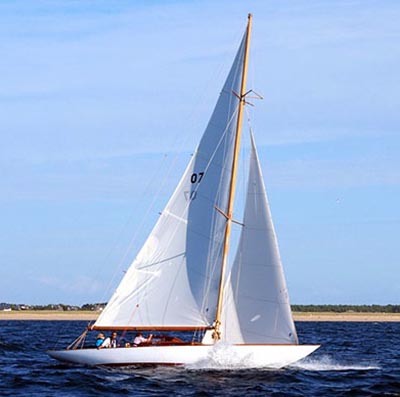 The restored Dublin Bay 24 Grace (ex-Periwinkle) is now reported to be based in Douarnenenz, but she would be very welcome back in Dublin Bay
The restored Dublin Bay 24 Grace (ex-Periwinkle) is now reported to be based in Douarnenenz, but she would be very welcome back in Dublin Bay
Boats of a very different kind came centre stage many years ago in another Hal Sisk initiative, the Bantry Boats built to the design of the ship’s longboat left behind in Bantry after the unsuccessful French invasion of 1796. From the new involvement came the Atlantic Challenge, and you’ll find Bantry Boats at many ports, though there are few enough of them in Ireland. But the Dun Laoghaire festivities would provide an ideal opportunity for them, as the final day of the regatta, Sunday 9th July, is also being pencilled in for a full-on traditional rowing competition for the East Coast Skiffs.
 The Pembrokeshire Bantry Boat sailing off the coast of southwest Wales. Some racing for these very special craft is another proposal for the Dun Laoghaire regatta
The Pembrokeshire Bantry Boat sailing off the coast of southwest Wales. Some racing for these very special craft is another proposal for the Dun Laoghaire regatta
In fact, with so much effort being made to provide proper waterfront facilities in Dun Laoghaire, it’s a case of the more the merrier, and another interesting vessel whose management have indicated positive interest is the Conor O’Brien ketch Ilen, currently nearing completion of her restoration through the Ilen Boat Building School of Limerick at Liam Hegarty’s boatyard at Oldcourt near Baltimore.
Ilen is due to be launched in April and will be in full commission by July. The very fact of having a complete suit of new sails will make her look better than she ever has since she was built in 1927, and if she does turn up to Dun Laoghaire welcome, it will be a very different boat from the tired-looking vessel at the end of her working days in the Falkands, the vessel which was finally, thanks to Gary MacMahon’s initiative, returned to Ireland in 1998.
In other words, so many ideas are flying around about the fresh shapes and new vitality that the Kingstown Bicentenary can add to the Volvo Dun Laoghaire Regatta that all things are possible.
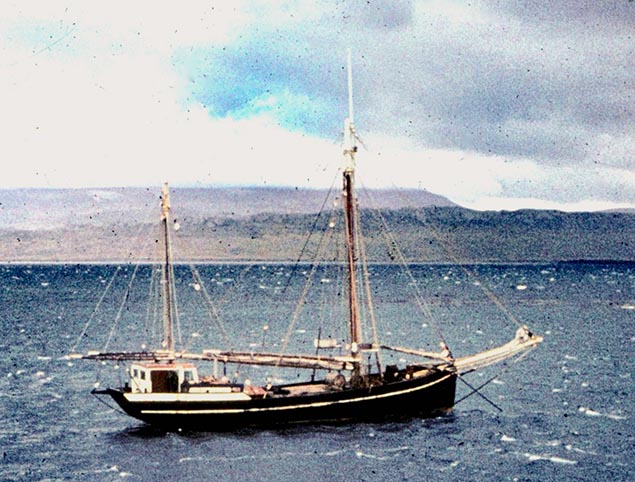 The Conor O’Brien ketch Ilen towards the end of her working days in the Falkland Islands. In fully restored form, she is expected to launch in April of this year, and may well include the Volvo Dun Laoghaire Regatta in her 2017 programme. Photo courtesy Ilen Boatbuilding School
The Conor O’Brien ketch Ilen towards the end of her working days in the Falkland Islands. In fully restored form, she is expected to launch in April of this year, and may well include the Volvo Dun Laoghaire Regatta in her 2017 programme. Photo courtesy Ilen Boatbuilding School
When the report appeared here on Afloat.ie on Monday about the assistance given by Arklow RNLI to the “stranded” classic yacht off the Arklow pierheads on May 1st, warning bells rang writes W M Nixon.
For classic boat enthusiasts will have instantly recognised that the yacht in question is the 43ft ketch Maybird, built by Tyrrells of Arklow in 1937, and superbly restored in the heart of the classic yacht industry in Southampton between 2009 and 2011 by a team of all the talents in a job project-managed by owner Darryl Hughes.
Most folk on the classic yacht circuit will be aware that Maybird is entered for the Volvo Round Ireland Race from Wicklow on June 18th, in which she’ll be the oldest boat ever to have taken part. And those of us really in the know will have been aware that Darryl Hughes hopes that members of Arklow Sailing Club - and maybe even descendants of the men who built the boat back in 1937 – will be on the crew for the big race.
The Arklow maritime community being what it is, many members of the sailing club are also on the RNLI Lifeboat Crew panel, and thus some of them were on board Maybird when she set off from Cork Harbour to sail for Arklow early last Saturday as part of a programme to build up mileage experience in order to qualify for the round Ireland.
So when the photo appeared on Monday showing Maybird about to be taken in tow on Sunday evening by the Arklow lifeboat after her engine had failed right in the entrance to Arklow Harbour, at first all we could think of was the embarrassment of those on Maybird at having to be “rescued” by their colleagues.
But then we remembered that May 1st, May Day, is a great lifeboat fund-raising day, and particularly so in Arklow. So then cynical thoughts took over, thinking that maybe this was a cleverly-planned fund-raising stunt: Maybird, Mayday, May*rs* we thought.
There are times you can be just too hard-bitten. Turns out the whole story is absolutely kosher. Prior to leaving winter quarters in Crosshaven, when servicing the engine Darryl had noticed the bleed screw on the secondary fuel filter did not seem to be making an airtight fit. But the engine started with no bother, and motored the boat without trouble from Crosshaven to the Custom House Quay in Cork to meet the Arklow crew, and then took Maybird, with full complement aboard, down to Cobh on Friday evening to prepare for departure towards Arklow last Saturday morning.
They’d a fine sail round to the east coast, going outside the Tuskar to simulate round Ireland conditions, but then off the Glassgorman Bank an engine start test failed. There was air in the fuel system, but Darryl solved the problem with plumbers’ PTFE tape on the bleed screw, and they were back in business with a fading breeze, motoring the final miles and stowing sails with the engine performing well.
But just as the pierheads came abeam, the engine cut out. Fortunately Maybird’s multiple-sail rig provides almost instant hoisting of the staysail – “always the last sail to be stowed” – and they were able to sail clear and keep the situation under control while the Arklow lifeboat leapt at the chance to carry out a rescue.
As it happens, Jimmy Mylor, who organises the Arklow Sea Scouts in addition to being on the Lifeboat Crew, had meant to be on Maybird, but work commitments had caused him to drop out. Yet it was he who handed Maybird’s crew the lifeboat’s towing warp amidst much banter, banter which went on for some time.
But now the Arklow marine industry have rallied round to make sure that a new bleed screw on Maybird’s secondary filter is getting a proper seal, and all being well, Maybird will race this Saturday in Arklow SC’s weekend event. We don’t know how much extra RNLI fund-raising was done as a result of this “stunt-for-real”. But the message yet again is that you can only have three problems with a good modern marine diesel engine – fuel, fuel, and fuel.

Maybird as she looks when all is as it should be


























